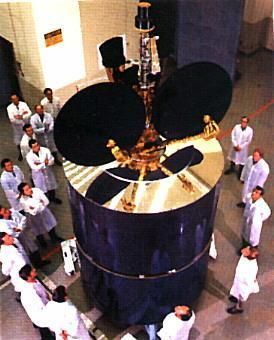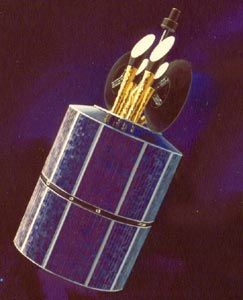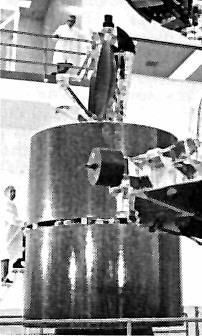
Home - Search - Browse - Alphabetic Index: 0- 1- 2- 3- 4- 5- 6- 7- 8- 9
A- B- C- D- E- F- G- H- I- J- K- L- M- N- O- P- Q- R- S- T- U- V- W- X- Y- Z
Intelsat 4
 Intelsat 4 Credit: Intelsat |
Status: Operational 1971. First Launch: 1971-01-26. Last Launch: 1975-05-22. Number: 8 . Gross mass: 1,410 kg (3,100 lb). Height: 5.30 m (17.30 ft).
The series included the first commercial communications satellite built outside of the United States (F4 was assembled by British Aircraft Corporation). Operational lifetimes were: F1 - 3 years for ITSO, then leased out; F2 - 12 years; F3 - 12 years, then placed into orbital storage; F4 - over 7 years; F5 - over 7 years ; F6 - 0 years (failed to orbit); F7 - over 6 years, then placed into orbital storage; F8 - 9 years (?). Spacecraft: Spin stabilized with a despun antenna structure. Hydrazine propulsion system. Passive thermal control. Body mounted solar cells. Payload: Twelve transponders. Multiple access.4000 voice circuits or 2 TV channels.
More at: Intelsat 4.
| Intelsat 4A American communications satellite. Intelsat 4A satellites increased satellite capacity to 7250 voice circuits or 2 TV channels. Built by Hughes for Intelsat, International. Launched 1975 - 1978. Used the HS-353 bus. |
Family: Communications, Geosynchronous orbit. Country: USA. Engines: SVM-4. Launch Vehicles: Atlas, Atlas SLV-3C Centaur, Atlas SLV-3D Centaur. Projects: Intelsat. Launch Sites: Cape Canaveral, Cape Canaveral LC36A, Cape Canaveral LC36B. Agency: Hughes. Bibliography: 126, 2, 278, 6, 5020, 12664.
 | Intelsat 4 F-1 Credit: Manufacturer Image |
 | Intelsat 4 Credit: Intelsat |
1971 January 26 - . 00:36 GMT - . Launch Site: Cape Canaveral. Launch Complex: Cape Canaveral LC36A. LV Family: Atlas. Launch Vehicle: Atlas SLV-3C Centaur.
- Intelsat 4 F-2 - .
Mass: 706 kg (1,556 lb). Nation: International.
Agency: Intelsat.
Program: Intelsat.
Class: Communications.
Type: Civilian communications satellite. Spacecraft Bus: HS 312 / HS 351 / HS 353.
Spacecraft: Intelsat 4.
Completed Operations Date: 1983-05-11 . USAF Sat Cat: 4881 . COSPAR: 1971-006A. Apogee: 36,236 km (22,515 mi). Perigee: 36,151 km (22,463 mi). Inclination: 15.30 deg. Period: 1,457.00 min.
Launch vehicle put payload into geosynchronous transfer orbit; the satellite performed the apogee burn and positioned itself in geosynchronous orbit over the Atlantic Ocean at 24.5 deg W. Subsequently at 23 deg W in 1971-1975; over the Atlantic Ocean 1-6 deg W in 1976-1980; over the Atlantic Ocean 0-5 deg E in 1980-1983. As of 3 September 2001 at 31.91 deg E drifting at 5.168 deg W per day. As of 2006 Dec 18 located at 133.93E drifting at 5.166W degrees per day. Spacecraft engaged in practical applications and uses of space technology such as weather or communication (US Cat C).
1971 December 20 - . 01:10 GMT - . Launch Site: Cape Canaveral. Launch Complex: Cape Canaveral LC36A. LV Family: Atlas. Launch Vehicle: Atlas SLV-3C Centaur.
- Intelsat 4 F-3 - .
Mass: 1,410 kg (3,100 lb). Nation: International.
Agency: Intelsat.
Program: Intelsat.
Class: Communications.
Type: Civilian communications satellite. Spacecraft Bus: HS 312 / HS 351 / HS 353.
Spacecraft: Intelsat 4.
Completed Operations Date: 1984-02-23 . USAF Sat Cat: 5709 . COSPAR: 1971-116A. Apogee: 36,009 km (22,374 mi). Perigee: 35,930 km (22,320 mi). Inclination: 11.10 deg. Period: 1,445.50 min.
Over Atlantic. Spacecraft engaged in practical applications and uses of space technology such as weather or communication (US Cat C). Launch vehicle put payload into geosynchronous transfer orbit Positioned in geosynchronous orbit over the Atlantic Ocean at 20-25 deg W in 1972-1976; over the Atlantic Ocean 34 deg W in 1976-1977; over the Atlantic Ocean 18-22 deg W in 1977-1980; over the Atlantic Ocean 53 deg W in 1981-1982; over the Atlantic Ocean 38-44 deg W in 1982-1983 As of 4 September 2001 located at 90.58 deg E drifting at 2.365 deg W per day. As of 2007 Mar 10 located at 54.69E drifting at 2.365W degrees per day.
1972 January 23 - . 00:12 GMT - . Launch Site: Cape Canaveral. Launch Complex: Cape Canaveral LC36B. LV Family: Atlas. Launch Vehicle: Atlas SLV-3C Centaur.
- Intelsat 4 F-4 - .
Mass: 1,410 kg (3,100 lb). Nation: International.
Agency: Intelsat.
Program: Intelsat.
Class: Communications.
Type: Civilian communications satellite. Spacecraft Bus: HS 312 / HS 351 / HS 353.
Spacecraft: Intelsat 4.
Completed Operations Date: 1983-05-10 . USAF Sat Cat: 5775 . COSPAR: 1972-003A. Apogee: 35,917 km (22,317 mi). Perigee: 35,905 km (22,310 mi). Inclination: 10.50 deg. Period: 1,442.50 min.
Over Pacific. Spacecraft engaged in practical applications and uses of space technology such as weather or communication (US Cat C). Launch vehicle put payload into geosynchronous transfer orbit Positioned in geosynchronous orbit over the Pacific Ocean at 174 deg E in 1972-1974; over the Pacific Ocean 179 deg E in 1975-1982; over the Atlantic Ocean 1 deg W in 1982-1983 As of 28 August 2001 located at 178.00 deg E drifting at 1.569 deg W per day. As of 2007 Mar 7 located at 155.84W drifting at 1.593W degrees per day.
1972 June 13 - . 21:53 GMT - . Launch Site: Cape Canaveral. Launch Complex: Cape Canaveral LC36B. LV Family: Atlas. Launch Vehicle: Atlas SLV-3C Centaur.
- Intelsat 4 F-5 - .
Mass: 1,410 kg (3,100 lb). Nation: International.
Agency: Intelsat.
Program: Intelsat.
Class: Communications.
Type: Civilian communications satellite. Spacecraft Bus: HS 312 / HS 351 / HS 353.
Spacecraft: Intelsat 4.
Completed Operations Date: 1983-02-23 . USAF Sat Cat: 6052 . COSPAR: 1972-041A. Apogee: 35,847 km (22,274 mi). Perigee: 35,811 km (22,251 mi). Inclination: 11.30 deg. Period: 1,438.30 min.
Over Indian Ocean. Spacecraft engaged in practical applications and uses of space technology such as weather or communication (US Cat C). Launch vehicle put payload into geosynchronous transfer orbit Positioned in geosynchronous orbit over the Indian Ocean at 61 deg E in 1972-1975; over the Indian Ocean 60 deg E in 1976-1980; over the Pacific Ocean 179 deg E in 1980-1981 As of 2 September 2001 located at 8.61 deg E drifting at 0.536 deg W per day. As of 2007 Mar 9 located at 73.10W drifting at 0.625W degrees per day.
1973 August 23 - . 22:57 GMT - . Launch Site: Cape Canaveral. Launch Complex: Cape Canaveral LC36A. LV Family: Atlas. Launch Vehicle: Atlas SLV-3D Centaur.
- Intelsat 4 F-7 - .
Mass: 1,410 kg (3,100 lb). Nation: International.
Agency: Intelsat.
Program: Intelsat.
Class: Communications.
Type: Civilian communications satellite. Spacecraft Bus: HS 312 / HS 351 / HS 353.
Spacecraft: Intelsat 4.
Completed Operations Date: 1984-02-23 . USAF Sat Cat: 6796 . COSPAR: 1973-058A. Apogee: 36,132 km (22,451 mi). Perigee: 36,080 km (22,410 mi). Inclination: 10.40 deg. Period: 1,452.50 min.
Over Atlantic Ocean. Spacecraft engaged in practical applications and uses of space technology such as weather or communication (US Cat C). Launch vehicle put payload into geosynchronous transfer orbit Positioned in geosynchronous orbit over the Atlantic Ocean at 30 deg W in 1973-1976 over the Atlantic Ocean 1 deg W in 1976-1980; over the Indian Ocean 56 deg E in 1980-1981; over the Pacific Ocean179 deg E in 1981-1982; over the Atlantic Ocean 53 deg W in 1982-1983 As of 31 August 2001 located at 74.52 deg W drifting at 4.067 deg W per day. As of 2007 Mar 10 located at 19.61E drifting at 4.058W degrees per day.
1974 November 21 - . 23:43 GMT - . Launch Site: Cape Canaveral. Launch Complex: Cape Canaveral LC36B. LV Family: Atlas. Launch Vehicle: Atlas SLV-3D Centaur.
- Intelsat 4 F-8 - .
Mass: 1,410 kg (3,100 lb). Nation: International.
Agency: Intelsat.
Program: Intelsat.
Class: Communications.
Type: Civilian communications satellite. Spacecraft Bus: HS 312 / HS 351 / HS 353.
Spacecraft: Intelsat 4.
Completed Operations Date: 1985-08-20 . USAF Sat Cat: 7544 . COSPAR: 1974-093A. Apogee: 35,944 km (22,334 mi). Perigee: 35,907 km (22,311 mi). Inclination: 8.80 deg. Period: 1,443.20 min.
Spacecraft engaged in practical applications and uses of space technology such as weather or communication (US Cat C). Launch vehicle put payload into geosynchronous transfer orbit Positioned in geosynchronous orbit over the Pacific Ocean at 174 deg E in 1974-1982; over the Pacific Ocean 179 deg E in 1982; over the Atlantic Ocean 1 deg W in 1983-1985 As of 1 September 2001 located at 139.80 deg W drifting at 1.762 deg W per day. As of 2007 Mar 9 located at 61.11W drifting at 1.754W degrees per day.
1975 February 20 - . 23:35 GMT - . Launch Site: Cape Canaveral. Launch Complex: Cape Canaveral LC36A. LV Family: Atlas. Launch Vehicle: Atlas SLV-3D Centaur. FAILURE: Staging electrical disconnect.. Failed Stage: U.
- Intelsat 4 F-6 - . Mass: 1,410 kg (3,100 lb). Nation: International. Agency: Intelsat. Program: Intelsat. Class: Communications. Type: Civilian communications satellite. Spacecraft Bus: HS 312 / HS 351 / HS 353. Spacecraft: Intelsat 4. Decay Date: 1975-02-20 . Staging electrical disconnect. Launch vehicle was to have put payload into geosynchronous transfer orbit.
1975 May 22 - . 22:04 GMT - . Launch Site: Cape Canaveral. Launch Complex: Cape Canaveral LC36A. LV Family: Atlas. Launch Vehicle: Atlas SLV-3D Centaur.
- Intelsat 4 F-1 - .
Mass: 727 kg (1,602 lb). Nation: International.
Agency: Intelsat.
Program: Intelsat.
Class: Communications.
Type: Civilian communications satellite. Spacecraft Bus: HS 312 / HS 351 / HS 353.
Spacecraft: Intelsat 4.
Completed Operations Date: 1987-10-27 . USAF Sat Cat: 7815 . COSPAR: 1975-042A. Apogee: 36,128 km (22,448 mi). Perigee: 36,016 km (22,379 mi). Inclination: 8.90 deg. Period: 1,450.70 min.
Spacecraft engaged in practical applications and uses of space technology such as weather or communication (US Cat C). Launch vehicle put payload into geosynchronous transfer orbit Positioned in geosynchronous orbit over the Indian Ocean at 63 deg E in 1976-1978; over the Atlantic Ocean 17.0 deg W in 1978; over the Atlantic Ocean 18.5 deg W in 1979-1981; over the Pacific Ocean 174 deg E in 1982; over the Atlantic Ocean 53 deg W in 1983-1984; over the Atlantic Ocean 50 deg W in 1984-1987 As of 30 August 2001 located at 111.08 deg W drifting at 3.657 deg W per day. As of 2007 Mar 11 located at 95.13E drifting at 3.657W degrees per day.
Back to top of page
Home - Search - Browse - Alphabetic Index: 0- 1- 2- 3- 4- 5- 6- 7- 8- 9
A- B- C- D- E- F- G- H- I- J- K- L- M- N- O- P- Q- R- S- T- U- V- W- X- Y- Z
© 1997-2019 Mark Wade - Contact
© / Conditions for Use